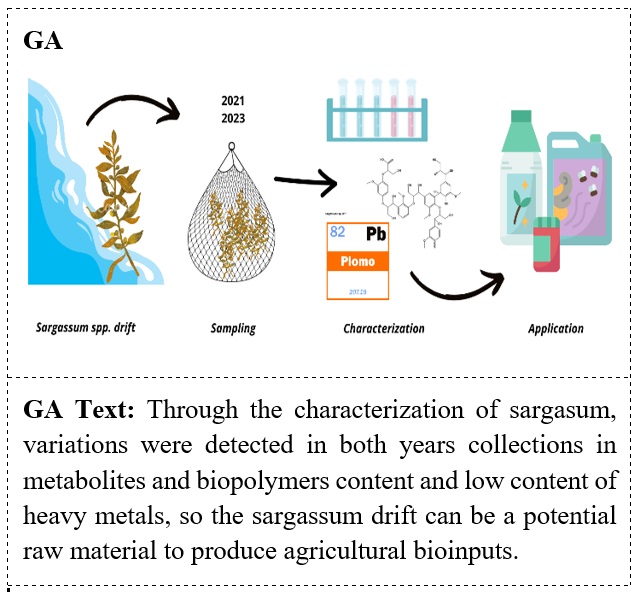Sargassum spp. drifts: characterization and potential agricultural use
Keywords:
macroalgae; biopolymers; metabolites; heavy metals; phytochemical screening.Abstract
The arrival of pelagic sargassum in Cuba is not a phenomenon of great magnitude as in other Caribbean regions, however, there is no adequate management of this biomass. The use of macroalgae in agriculture is a common practice. The objective of this research was to characterize sargassum collected from the Havana coast in December 2021 and March 2023 to detect variations in its chemical composition and to evaluate its potential for developing agricultural inputs. The collected samples were characterized by phytochemical screening, physico-chemical properties, and the content of heavy metals and natural polymers. In both collections, the presence of alkaloids, reducing sugars, amino compounds and steroids was noted; the physicochemical characteristics and biopolymer content varied between collections; and the concentration of metals was below the permissible limit. The results make sargassum a potential raw material for the production of agricultural bioinputs (biofertilizers, biostimulants or biomaterial).
References
WANG, M. et al. “The great Atlantic Sargassum belt”. Science. 2019. 365(6448), 83-87. DOI: 10.1126/science.aaw7912.
FIDAI, Y. A.; DASH, J.; TOMPKINS, E. L.; TONON, T. “A systematic review of floating and beach landing records of Sargassum beyond the Sargasso Sea”. Environ. Res. Commun. 2020. 2. 122001, 1-11 DOI: 10.1088/2515-7620/abd109.
PARDILHÓ, S. et al. “Back to the origins: Potential of beach-cast macroalgae as biofertilizer”. Waste and Biomass Valorization. 2022. 14, 1097-1111 DOI: 10.1007/s12649-022-01922-7.
TONON, T. et al. “Biochemical and elemental Composition of pelagic Sargassum biomass harvested across the Caribbean”. Phycology. 2022. 2, 204-215. DOI: 10.3390/phycology2010011.
MILLEDGE, J. J.; MANEEIN, S.; ARRIBAS, E.; BARTLETT, D. “Sargassum Inundations in Turks and Caicos: Methane Potential and Proximate, Ultimate, Lipid, Amino Acid, Metal and Metalloid Analyses”. Energies. 2020. 13, 1523. DOI: 10.3390/en13061523.
CRAIGIE, J. S. “Seaweed extract stimuli in plant science and agriculture”. J ApplPhycol. 2011. 23, 371-393. DOI: 10.1007/s10811-010-9560-4.
ESPINOSA ANTÓN, A. A.; HERNÁNDEZ-HERRERA, R. M.; GONZÁLEZ GONZÁLEZ, M. “Bioactive seaweed extracts as biostimulants of growth and protection of plants”. Biot. Veg. 2020. 20(4), 257-282. ISSN: 2074-8647.
PUGLIA, D. et al. “The Opportunity of Valorizing Agricultural Waste Through Its Conversion into Biostimulants, Biofertilizers and Biopolymers. Sustainability. 2021. 13, 2710. DOI: 10.3390/su13052710.
RONDINA, R. V.; COUSSIO, J. D. “Estudio Fitoquímico de Plantas Medicinales”. Rev. Invest. Agropec. 1969. 6(2), 352–66.
WORLD HEALTH ORGANIZATION. Quality control methods for medicinal plant materials. Geneva.1998. ISBN 92 4 154510 0 (NLM Classification: QV 766). URL: http://www.who.int/docs/default-source/medicines/ norms-and-tandards/guidelines/quality-control/ quality-control-methods-for-medicinal-plant-materials.pdf?sfvrsn=b451e7c6_0
GÓMEZ, ORDÓÑEZ, E. Evaluación nutricional y propiedades biológicas de algas marinas comestibles. Estudios in vitro e in vivo. Tesis doctoral. Universidad Complutense de Madrid. España, 2013. Disponible en: http://api.semanticscholar.org/CorpusID:82051863
MAHYATI, A. R.; PATONG, M. N.; DJIDE, D.; TABA, P. “Biodegradation of lignin from corn cob by using a mixture of Phanerochaete chrysosporium, Lentinus edodes and Pleurotus ostreatus”. International Journal of Scientific & Technology Research. 2013. 2(11), 79-82. ISSN 2277-8616.
PONCE, L. R.; DEL BARRIO, G. C.; SPENGLER, I.; RESIK, S.; ROQUE, A. “Evaluation of the antiviral activity of the brown algae Sargassum fluitans against Echovirus 9”. Rev. Med. Tropical. 2018. 70(2), 1-10. ISSN: 1561-3054 (Electrónico). https://www.medigraphic.com/cgibin/new/resumenI.cgi?IDARTICULO=83837
PRASEDYA, E. S. et al. “Effect of particle size on phytochemical composition and antioxidant properties of Sargassum cristaefolium etanol extract”. Scientific Reports. 2021. 11:17816. DOI: 10.1038/s41598-021-95769-y.
MARIMUTHU, J. et al. “Phytochemical characterization of brown seaweed Sargassumwightii”. Asian Pacific Journal of Tropical Disease. 2012. 2(Sup 1), S109-S113. DOI: 10.1016/S2222-1808(12)60134-0.
AMUTHA, J.; SATHIYA, G.; PERIYANAYAGAM, K. “Pharmacognostical study and phytochemical evaluation of brown seaweed Sargassumwightii”. Journal of Coastal Life Medicine. 2013. 1(3), 199-204. DOI: 10.12980/JCLM.1.2013C959.
SAMI, F.; YUSUF, M.; FAIZAN, M.; FARAZ, A.; HAYAT, S. “Role of sugars under abiotic stress”. Plant Fisiology and Biochemistry. 2016. 109, 54-61 DOI: 10.1016/j.plaphy.2016.09.005.
AI, N. et al. “Rapid Measurement of Cellulose, Hemicellulose and Lignin Content in Sargassum horneri by Near-Infrared Spectroscopy and Characteristic Variables Selection Methods”. Molecules. 2022. 27(335), 1-17. DOI: 10.3390/molecules2702335.
CUI, C. J. et al. “Insecticidal Activity and Insecticidal Mechanism of Total Saponins from Camellia oleifera”. Molecules. 2019. 24, 4518. DOI: 10.3390/molecules24244518.
MITHÖFER, A.; BOLAND, W. “Plant Defense Against Herbivores: Chemical Aspects”. Annu. Rev. Plant Biol. 2012. 63, 431-50. DOI: 10.1146/annurev-arplant-042110-103854.
AGUILERA, L. E.; CHANDÍA, N. P.; NEEDHAM, P.; Álvarez, C. “Efecto de polímeros algales sobre la productividad de uva bajo condiciones de riego deficitario”. Información Tecnológica. 2021. 32(5),29-36. DOI: 10.4067/S0718-07642021000500029.
SALGADO, E. et al. “Energy-saving pretreatments affect pelagic Sargassum composition and DNA metabarcoding reveals the microbial community involved in methane yield”. PLoS One. 2023. 18(8):e0289972. DOI: 10.1371/journal.pone.0289972.
PIÑA, J. J.; BALBÍN, A. I.; PÉREZ-CORDOVÉS, A. I. “La contaminación por metales pesados en sargazos procedentes de la costa sur en la península de Guanahacabibes”. Revista Cubana de Química. 2010. XXII (1), 83-88. ISSN: 0258-5995.
LÄHTEENMÄKI, A. et al. “European Union legislation on macroalgae product”. Aquaculture International. 2021. 29, 487-509. DOI: 10.1007/s10499-020-00633-x.
SAVY, D.; COZZOLINO, V.; VINCI, G.; NEBBIOSO, A.; PICCOLO, A. “Water-Soluble Lignins from Different Bioenergy Crops Stimulate the Early Development of Maize (Zea mays L.)”. Molecules. 2015. 20: 19958-19970. DOI: 10.3390/molecules201119671.

Downloads
Published
How to Cite
Issue
Section
License
Copyright (c) 2024 Amalia de la C. Díaz-Prieto, Kiara Zulueta-Prado, Orbel A. Marrero-Pérez, Mislén Gómez-Matos, Dariellys Martínez-Balmori

This work is licensed under a Creative Commons Attribution-NonCommercial-NoDerivatives 4.0 International License.
This journal provides immediate open access to its content, based on the principle that offering the public free access to research helps a greater global exchange of knowledge. Each author is responsible for the content of each of their articles.






















